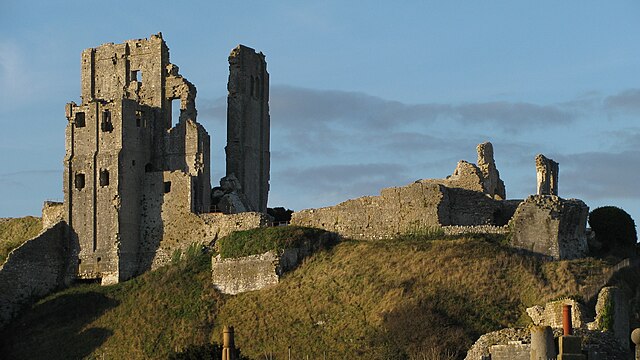Slighting is the deliberate damage of high-status buildings to reduce their value as military, administrative or social structures. This destruction of property is sometimes extended to the contents of buildings and the surrounding landscape. It is a phenomenon with complex motivations and was often used as a tool of control. Slighting spanned cultures and periods, with especially well-known examples from the English Civil War in the 17th century.
Corfe Castle in Dorset was slighted in 1646 during the English Civil War. Parliament slighted or proposed to slight more than 100 buildings, including castles, town walls, abbeys, and houses.
Slighting could extend beyond the building, and when Kenilworth Castle was slighted in 1649 the moat was drained.
Each method of destruction leaves a distinctive trace. At Newark Castle in Nottinghamshire the use of gunpowder left a crater damage pattern.
After the siege of Bedford Castle in 1224, Henry III had the garrison executed and the castle slighted, as illustrated by Matthew Paris.
The Anarchy was a civil war in England and Normandy between 1138 and 1153, which resulted in a widespread breakdown in law and order. The conflict was a war of succession precipitated by the accidental death of William Adelin who drowned in the White Ship disaster of 1120. Henry sought to be succeeded by his daughter, known as Empress Matilda, but was only partially successful in convincing the nobility to support her. On Henry's death in 1135, his nephew Stephen of Blois seized the throne, with the help of Stephen's brother Henry of Blois, who was the bishop of Winchester. Stephen's early reign saw fierce fighting with disloyal English barons, rebellious Welsh leaders, and Scottish invaders. Following a major rebellion in the south-west of England, Matilda invaded in 1139 with the help of her half-brother Robert of Gloucester.
Near contemporary illustration of the Battle of Lincoln; Stephen (fourth from the right) listens to Baldwin of Clare orating a battle speech (left)
Early 14th-century depiction of Henry I and the sinking of the White Ship off Barfleur in Normandy in 1120. British Library, London.
14th century depiction of King Stephen with a hunting bird
The keep at Goodrich in Herefordshire in the Welsh Marches, an example of the style of fortification slowly beginning to replace wooden motte and bailey castle designs by the late 1130s








